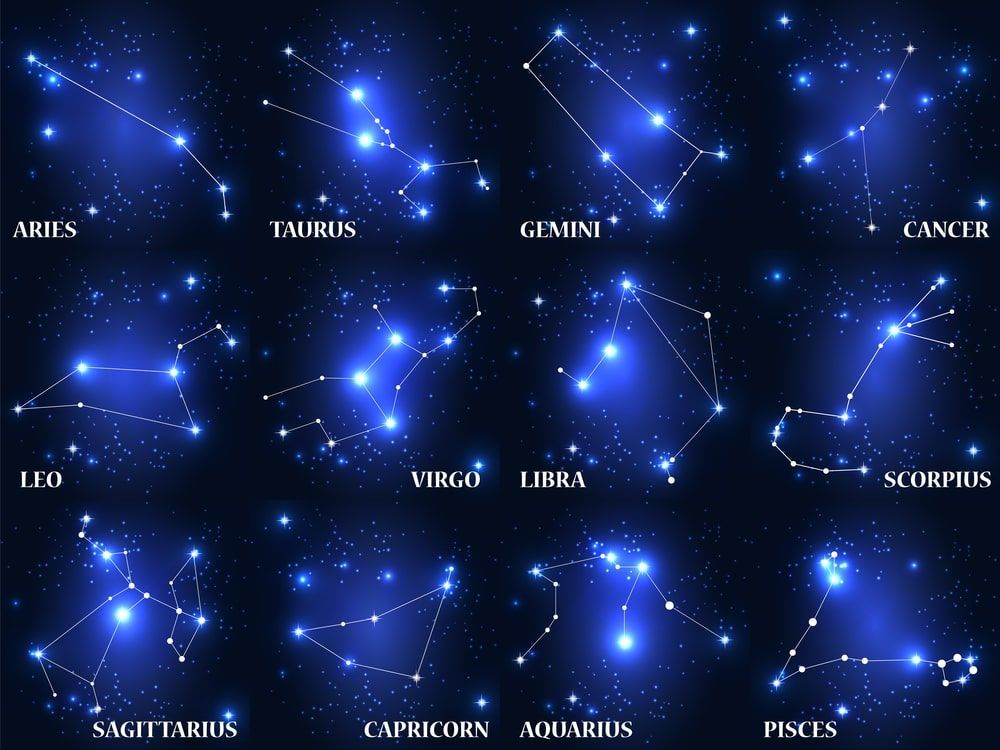Article
What Do You Know About the 13 Zodiac Constellations?
Do you know the definition of a constellation?

A constellation is a group of stars forming a recognizable pattern that is traditionally named after its apparent form or identified with a mythological figure. Modern astronomers divide the sky into eighty-eight constellations with defined boundaries.
Did you know there are 88 recognized constellations in the sky?
There are thirteen zodiac constellations out of those 88 which include:
Capricornus
- Best month to view: September
- Right Ascension: 21.02 hours
- Declination: -20 to -23 degrees
- Visible: Between latitudes 60 degrees and minus 90 degrees
- Did you know that the Capricornus is among the faintest of all the constellations?
Aquarius
- Best month to view: October
- Right Ascension: 22.71 hours
- Declination: -10.19 degrees
- Visible: Between 65 degrees and minus 90 degrees
- Did you know that the Aquarius is among the oldest of the documented constellations?
Pisces
- Best month to view: November between the 6th and 9th
- Right Ascension: 0.85 hours
- Declination: 11.08 degrees
- Visible: Between latitudes 90 degrees and minus 65 degrees.
- Did you know that if you live in the Northern Hemisphere it will be easier for you to scope out the Pisces?
Aries
- Best month to view: December
- Right Ascension: 3 hours
- Declination: 20 degrees
- Visible: Between latitudes 90 degrees and minus 60 degrees
- Did you know that the Aries constellation wasn’t recognized until 1922?
Taurus
- Best month to view: January
- Right Ascension: 4 hours
- Declination: 15 degrees
- Visible: Between latitudes 90 degrees and minus 65 degrees
- Did you know that the Taurus is the most visible of all the constellations?
Gemini
- Best month to view: February
- Right ascension: 7 hours
- Declination: 20 degrees
- Visible: Between latitudes 90 and minus 60 degrees
- Did you know that the Gemini is one of the few constellations that actually looks like its name?
Cancer
- Best month to view: March
- Right ascension: 9 hours
- Declination: 20 degrees
- Visible: Best seen between latitudes 90 degrees and minus 60 degrees
- Did you know that it is almost impossible to see the Cancer constellation with the naked eye?
Leo
- Best month to view: April
- Right ascension: 11 hours
- Declination: 15 degrees
- Visible: Between latitudes 90 and minus 65 degrees
- Did you know that the Leo constellation is the most recognizable of all the constellations and one of the few that resembles its name?
Virgo
- Best month to view: May
- Right Ascension: 13 hours
- Declination: 0 degrees
- Visible: Between latitudes 80 and minus 80 degrees
- Did you know that the Virgo constellation is the largest Zodiac constellation and contains 26 known exoplanets?
Libra
- Best month to view: June
- Right Ascension: 15.21 hours
- Declination: -15.59 degrees
- Visible: Between 65 degrees and minus 90 degrees
- Did you know that the Libra is the only zodiac constellation that represents an inanimate object?
Scorpius
- Best month to view: July
- Right Ascension: 17 hours
- Declination: minus 40 degrees
- Visible: Between latitudes 40 and minus 90 degree
- Did you know that the Scorpius constellation is one of the brightest in the sky?
Sagittarius
- Best month to view: August
- Right ascension: 19.11 hours
- Declination: -25.8 degrees.
- Visible: Between 55 degrees and minus 90 degree
- Did you know that the Sagittarius is the largest constellation in the Southern Hemisphere and is very visible with the naked eye?
Ophiuchus
- Best month to view: July
- Right Ascension: 17.18 hours
- Declination: -4.24 degrees
- Visible: Between 80 degrees and -80 degrees
- Did you know that astrologers ignored the Ophiuchus for centuries until 2011 when it was an added as an astrological sign?
If you need assistance using right ascension and declination to locate the constellations, refer to this helpful video: https://www.youtube.com/watch?v=XUbG8jboh4M
The Zodiac constellations are wildly popular, but most are unaware of the history behind each of the constellations. If you are interested in learning more about the constellations that fill our sky be sure to visit: http://www.space.com/15722-constellations.html to learn more!
share this
Related Articles
Related Articles










